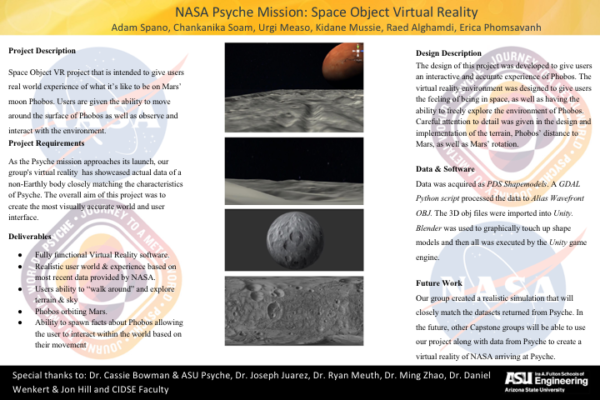Space Object VR (Phobos)
INSTITUTION
Arizona State University (Tempe Campus)
CLASS
Cobalt Class (2019 – 2020)
STUDENT TEAM
Adam Spano, Engineering Management
Chankanika Soam, Informatics
Erica Phomsavanh, Computer Science
Urgi Measo, Computer Science
Kidane Mussie, Computer Science
Raed Alghamdi, Computer Systems
SCIENTIFIC & TECHNICAL GUIDANCE
Jon Hill, Research Specialist, School of Earth and Space Exploration, ASU
Dr. Daniel Wenkert, NASA Jet Propulsion Laboratory
ACADEMIC GUIDANCE
Dr. Joe Juarez, Lecturer, School of Computing, Informatics, and Decision Systems Engineering, ASU
Dr. Ryan Meuth, Senior Lecturer, School of Computing, Informatics, and Decision Systems Engineering, ASU
Dr. Ming Zhao, Associate Professor, School of Computing, Informatics, and Decision Systems Engineering, ASU
Dr. Helen Chavez, Lecturer, School of Computing, Informatics, and Decision Systems Engineering, ASU
PROJECT DESCRIPTION
In preparation for arrival at the Psyche asteroid, our team worked to create a Virtual Reality experience on Phobos, using image data returned from the Mars Odyssey orbiter. The overall aim of this project was to create the most visually accurate world and user interface. The purpose is to showcase actual data and what is already known about Phobos and prepare for the datasets that will be returned from Psyche.
Deliverables include:
- Fully functional Virtual Reality software.
- Realistic user world & experience based on most recent NASA data.
- Users ability to move around to explore the terrain & sky
- Phobos orbiting Mars.
- Users ability to interact within the world to display factual data about Phobos.
This work was created in partial fulfillment of Arizona State University Capstone Courses “IEE 486, CSE424 & CSE486”. The work is a result of the Psyche Student Collaborations component of NASA’s Psyche Mission (https://psyche.asu.edu). “Psyche: A Journey to a Metal World” [Contract number NNM16AA09C] is part of the NASA Discovery Program mission to solar system targets. Trade names and trademarks of ASU and NASA are used in this work for identification only. Their usage does not constitute an official endorsement, either expressed or implied, by Arizona State University or National Aeronautics and Space Administration. The content is solely the responsibility of the authors and does not necessarily represent the official views of ASU or NASA.
and Space Administration. The content is solely the responsibility of the authors and does not necessarily
represent the official views of ASU or NASA


